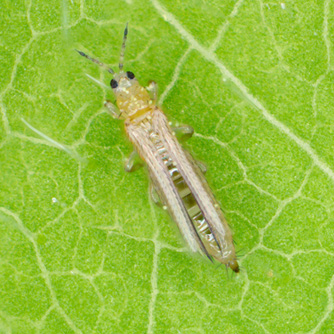Thrips
BackThrips are narrow little insects which are typically only 1-2mm long and 0.5mm wide. There are many different species and they range in colour from yellow to cream to black and brown. Some species are harmless to plants whilst others are extremely damaging including plague thrips, western flower thrips, onion thrips and chilli thrips.
Thrips cause damage by rasping and sucking on plant tissue including leaves and flowers. Damaged foliage will develop silvery streaks or mottling. Leaves may also curl and distort. Damage to petals typically results in browning of the petal edge and is more noticeable on paler flowers. When thrips feed inside young buds the resulting flower, fruit or leaves can be distorted. Their droppings are distinctive dark brown 'blobs' which stick to the leaves or petals they have been feeding on.
Some thrips can also spread viruses which can be especially damaging in the veggie patch.

Leaf discolouration caused by feeding thrips
Since thrips are small and spend much of their time hidden in the folds of foliage and flowers they often go unnoticed until the damage becomes severe. Controlling them can be difficult as it's hard for the spray to reach into where they congregate.
Plants Attacked by Thrips
Thrips attack a wide range of plants including veggies, fruit trees and ornamentals like roses, carnations, gladioli and other bulbs.
Organic Control Methods for Thrips
Spray plants very thoroughly at the first sign of thrips damage with either OCP eco-insect killer or OCP eco-pyrethrum PLUS. Repeat spray a week later and then monitor plants closely for signs of continued thrips activity.

Close up image of an onion thrips
Remove any weeds from the area, especially in the veggie patch, as they can act as host plants for thrips.
There are predatory insects which will feed on thrips, like ladybeetles and lacewings, so plant a range of flowering plants around your garden to help attract more of these beneficial insects.

Distorted leaves caused by ficus thrips


